Key difference: Oils are vital ingredients used for culinary or cooking purposes. There are numerous verities of edible vegetable oils found in nature which are highly applicable in food processing and purposes. Oils and their fat types are health friendly and beneficial in many aspects.
Oils are their fat concentrations are essential components in day to day food consumption. Food rich in monounsaturated, polyunsaturated and saturated fats compositions, play different roles in different
sectors. Cooking oils are typically liquid in state, while some does contains saturated fats, which
keeps them solid at room temperatures.
sectors. Cooking oils are typically liquid in state, while some does contains saturated fats, which
keeps them solid at room temperatures.
The word ‘cooking oils’ derives oils used for cooking purposes. Cooking oils are
obtained from various different sources of plants, animals, and synthetic fat compositions.
Hence these are applicable in various frying, baking, and other types of cooking purposes.
Oils as whole are commercially used on a large scale for the fast food and other industries for f
rying and other related usages. Along with culinary usages,these oils have numerous medicinal properties, which make them perfect for particular health and medicinal problems.
Hence oils have health nourished qualities which makes them a perfect choice in the food and health
related issues.
obtained from various different sources of plants, animals, and synthetic fat compositions.
Hence these are applicable in various frying, baking, and other types of cooking purposes.
Oils as whole are commercially used on a large scale for the fast food and other industries for f
rying and other related usages. Along with culinary usages,these oils have numerous medicinal properties, which make them perfect for particular health and medicinal problems.
Hence oils have health nourished qualities which makes them a perfect choice in the food and health
related issues.
The different types of oils are based on their appropriate fat compositions and smoke points, hence are
relevant in various
cooking and other health benefits; the list and explanation below will give a quick view regarding these oils and their usages:
relevant in various
cooking and other health benefits; the list and explanation below will give a quick view regarding these oils and their usages:
Comparison between different types of Cooking Oil:
 Coconut oil (virgin):
Coconut oil (virgin):- Saturated-92%
- Monounsaturated-6%
- Polyunsaturated-2%
- Smoke point-177 °C (351 °F)
The oil is extracted from the matured coconut kernel or meat; and has uncountable health benefits. The oil is world famous for its skin and hair therapies; along with ability to prevent and cure the digestive system issues and problems related to stomach, like the Irritable Bowel Syndrome. It is highly effective for bruises, as the oil speeds up the healing of damaged tissues.
Commercially, it is used for baked goods, candy and sweets, whipped toppings, nondairy coffee creamers and
shortening purposes.
Commercially, it is used for baked goods, candy and sweets, whipped toppings, nondairy coffee creamers and
shortening purposes.
 Sunflower oil:
Sunflower oil:- Saturated-9%
- Monounsaturated-82%
- Polyunsaturated-9%
- Smoke point-160 °C (320 °F)
The oil is obtained from sunflower seeds. Its nutritious composition makes it one
of the healthiest oils for consumption as well as application on skin and hair.
Sunflower oil has an effective application in the skin treatment; hence it is used
as an emollient in the cosmetic industries. It is used for cooking, salad dressings
and as a substitute of margarine.
of the healthiest oils for consumption as well as application on skin and hair.
Sunflower oil has an effective application in the skin treatment; hence it is used
as an emollient in the cosmetic industries. It is used for cooking, salad dressings
and as a substitute of margarine.
.jpg) Olive oil (extra virgin):
Olive oil (extra virgin):- Saturated-14%
- Monounsaturated-73%
- Polyunsaturated-11%
- Smoke point-190 °C (374 °F)
The oil and their types are extracted from olive fruits. Olive oils are categorized according to their grades, they are: virgin, lampante, extra-virgin and refined oil. The oils are known for their health effects and advised in the food science; they are used in cooking and suggested by dieticians in the health tips. They are applicable in cooking, cosmetics, pharmaceuticals, and soaps and as fuel for traditional oil lamps. Used for cooking, salad oils and as a substitute for margarine.
.jpg) Peanut oil:
Peanut oil:- Saturated-18%
- Monounsaturated-49%
- Polyunsaturated-33%
- Smoke point-231 °C (448 °F)
The oil is commonly known as groundnut oil (or arachis oil), as it is extracted from groundnuts or peanuts. Peanut oil is considered to be one among the healthiest
vegetable oils, as it is naturally trans fat-free, cholesterol free, and low in saturated
fats. Used for frying, cooking, salad oils, and as a substitute for margarine.
vegetable oils, as it is naturally trans fat-free, cholesterol free, and low in saturated
fats. Used for frying, cooking, salad oils, and as a substitute for margarine.
.jpg)
Palm oil:
- Saturated-52%
- Monounsaturated-38%
- Polyunsaturated-10%
- Smoke point-230 °C (446 °F)
Oil and their types are obtained from pulp of palm fruits. The red Palm oil is beneficial in skin and other cosmetic applications. Red palm oil does not contain cholesterols and hence can be consumed in normal diet and also by the ones having from high cholesterols. Also, the oil has antioxidant properties and hence can fight free radicals in the bloodstream which leads to
prevention of few heart diseases. Used for cooking, flavoring, vegetable oil, and shortening purposes.
prevention of few heart diseases. Used for cooking, flavoring, vegetable oil, and shortening purposes.
 Corn oil:
Corn oil:- Saturated-13%
- Monounsaturated-25%
- Polyunsaturated-62%
- Smoke point-236 °C (457 °F)
Oil is obtained from germ of corn or maize seeds. The oil is highly regarded to be
best in its functionality, exceptional flavor, economy, and health benefits.
Commercially, the oil is one among the most preferred oils in the snack food
industries and restaurants. Used for Frying, baking, salad dressings, margarine and shortening purposes.
best in its functionality, exceptional flavor, economy, and health benefits.
Commercially, the oil is one among the most preferred oils in the snack food
industries and restaurants. Used for Frying, baking, salad dressings, margarine and shortening purposes.
.jpg) Canola oil:
Canola oil:- Saturated-6%
- Monounsaturated-62%
- Polyunsaturated-32%
- Smoke point-204 °C (399 °F)
Oil is extracted from canola or rapeseeds. The oil is also used in industrial purposes like industrial lubricants, bio-fuels, candles, lipsticks, and newspaper inks depending on the price on the spot market. The oil is regarded to be the fertility-preserving vaginal lubricant, also for reducing the growth of cancer cells. Used for Frying, baking and in salad dressings.
 Grape seed oil:
Grape seed oil:- Saturated-12%
- Monounsaturated-17%
- Polyunsaturated-71%
- Smoke point-204 °C (399 °F)
Oil is extracted from the grape seeds, which are the grape fruit
by-products obtained after wine making. Grape seed oil is one among the essential
oils which are applicable in aromatherapy. The oil acts as a base in infusions of garlic, rosemary, or other herbs or spices. Industrially, this oil is used in cosmetics products,
as it can control the moisture content of skin. It is also used as a lubricant for shaving. Used for frying, cooking, salad oils, and as a substitute for margarine.
by-products obtained after wine making. Grape seed oil is one among the essential
oils which are applicable in aromatherapy. The oil acts as a base in infusions of garlic, rosemary, or other herbs or spices. Industrially, this oil is used in cosmetics products,
as it can control the moisture content of skin. It is also used as a lubricant for shaving. Used for frying, cooking, salad oils, and as a substitute for margarine.
.jpg) Mustard oil:
Mustard oil:- Saturated-13%
- Monounsaturated-60%
- Polyunsaturated-21%
- Smoke point-254 °C (489 °F)
Oil removed from mustard seeds, is typical with a pungent odor and dark color. But, the refined form is much better and hence is applicable for various cooking benefits. Apart from cooking, the oil also has been used in the Ayurvedic sectors for its healing and medicinal properties. Also, it is considered to be beneficial for hair, skin and body. Generally used for cooking, frying, deep frying, salads, dressings; it is very clean flavored & palatable type of oil.
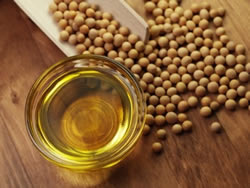 Soybean oil:
Soybean oil:- Saturated-15%
- Monounsaturated-24%
- Polyunsaturated-61%
- Smoke point-241 °C (466 °F)
Oil obtained from soybean seeds is in great demand in the world oil marts.
The versatility of the oil is that it has an imperceptible odor support which enhances
the natural flavors of prepared foods. Used for cooking, salad dressings, vegetable
oil, margarine, and shortening purposes.
The versatility of the oil is that it has an imperceptible odor support which enhances
the natural flavors of prepared foods. Used for cooking, salad dressings, vegetable
oil, margarine, and shortening purposes.
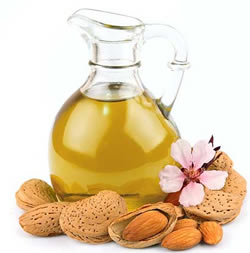
Almond oil:
- Saturated-8%
- Monounsaturated-66%
- Polyunsaturated-26%
- Smoke point-221 °C (430 °F)
The oil has resulted beneficial in many cosmetic and skin creams. The best thing about the oil is that, it gets soaked inside the skin quickly and leaves behind only a slight type of residue. So, it can be applied in less quantity to cover the entire facial skin. Also, applicable for cooking, in Baking, sauces, flavoring.
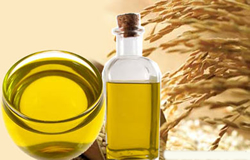 Rice bran oil:
Rice bran oil:- Saturated-20%
- Monounsaturated-47%
- Polyunsaturated-33%
- Smoke point-254 °C (489 °F)
This oil is obtained from the rice husks (rice bran) and germs
and is highly stable oil, of nut-flavored. The oil contains a remarkable amount of nutritive constituents; which contains vitamins and antioxidants; also it is regarded to be of trans free fat nature, hence is more preferred by health conscious individuals. Used in cooking, frying, deep frying, salads, dressings; even this oil is one among the very clean flavored & palatable types of oils.
and is highly stable oil, of nut-flavored. The oil contains a remarkable amount of nutritive constituents; which contains vitamins and antioxidants; also it is regarded to be of trans free fat nature, hence is more preferred by health conscious individuals. Used in cooking, frying, deep frying, salads, dressings; even this oil is one among the very clean flavored & palatable types of oils.
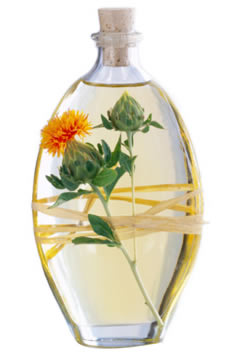 Safflower oil:
Safflower oil:- Saturated-10%
- Monounsaturated-13%
- Polyunsaturated-77%
- Smoke point-265 °C (509 °F)
Oil is extracted from safflower seeds; belonging to the sunflower plant family. The oil exists in two different types: high in monounsaturated fatty acid (oleic acid) and other high in polyunsaturated fatty acid (linoleic acid). They prove to be beneficial for dietary purposes; as it helps to regulate the blood glucose levels and fatty-acid breakdown process. Used for frying, cooking, salad oils, and as a substitute for margarine.
.jpg) Sesame oil (semi-refined):
Sesame oil (semi-refined):- Saturated-14%
- Monounsaturated-43%
- Polyunsaturated-43%
- Smoke point-232 °C (450 °F)
Sesame oil is derived from the sesame seeds, the oil is best known for its antiviral functions. The usage of the
oil is specifically found in the cosmetic industries, due to its anti-fungal and anti-bacterial properties. The oil stops the growth of common skin pathogens, such as staphylococcus and streptococcus as well as common skin fungi, such as athlete's foot fungus. Used for Cooking and deep frying purposes.
oil is specifically found in the cosmetic industries, due to its anti-fungal and anti-bacterial properties. The oil stops the growth of common skin pathogens, such as staphylococcus and streptococcus as well as common skin fungi, such as athlete's foot fungus. Used for Cooking and deep frying purposes.
 Avocado oil:
Avocado oil:- Saturated-12%
- Monounsaturated-74%
- Polyunsaturated-14%
- Smoke point-271 °C (520 °F)
Oil is obtained from fruit of the persea americana (avocado). The oil is known for its cosmetic use because it’s very high skin penetrating and rapid absorbing. Extra virgin avocado oil from the Hass cultivar has a characteristic flavor. Used for frying, sautéing, dipping oil and as a salad oil.
 Walnut oil (semi-refined):
Walnut oil (semi-refined):- Saturated-9%
- Monounsaturated-23%
- Polyunsaturated-63%
- Smoke point-204 °C (399 °F)
Oil is extracted from English walnuts (also known as Persian walnuts). It’s considered
to be the costlier of all oils, and hence is used less in the food and cooking purposes.
It acts as a good oil paint base thinner and brush cleaner. Used for salad dressings and is generally added to cold dishes to enhance flavor.
to be the costlier of all oils, and hence is used less in the food and cooking purposes.
It acts as a good oil paint base thinner and brush cleaner. Used for salad dressings and is generally added to cold dishes to enhance flavor.
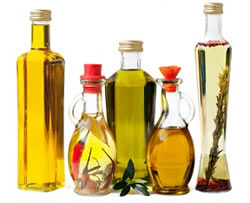 Other Remaining oils:
Other Remaining oils:
Other such cooking oils are Pumpkin seed oil, Hemp oil, Flaxseed oil and etc. some of which are used for many commercial and culinary purposes. Along with these specific oils, butter, ghee, margarine and lard are also used for cooking purposes.
Hence, from the above list, it might have been clear that the mentioned cooking oils play specific roles for healthy life maintenance; hence are used for cooking purposes in different areas according to their availability.
Credit Image Courtesy: timigustafson.com, monsterwebsearch.com, booboone.com, bulkapothecary.com, whatiscalled.com, livesmart360news.com, leopureoil.com, gfbyvickypearl.com, eyelashesbyalina.com, oilforhair.org, blog.fooducate.com, beautyglimpse.com, medindia.net, sagerfoods.com, makeupandbeauty.com, paradisegroveavocados.com, kalcek.si, arganoilshop.com
credit/source; http://www.differencebetween.info/different-types-of-cooking-oil
No comments:
Post a Comment
Note: Only a member of this blog may post a comment.